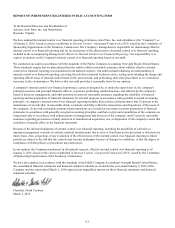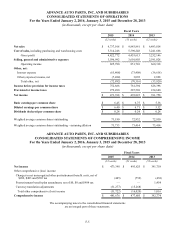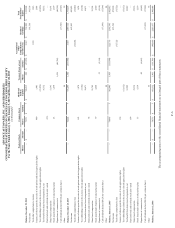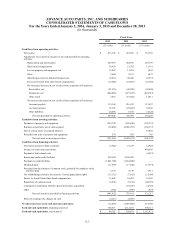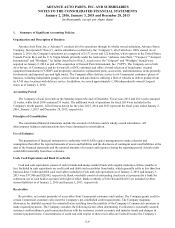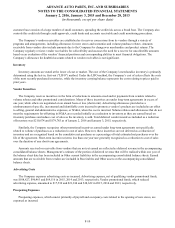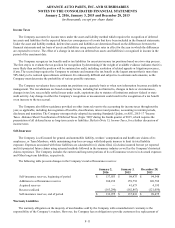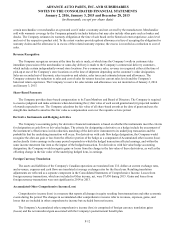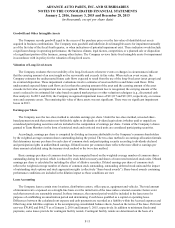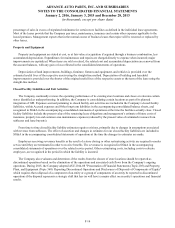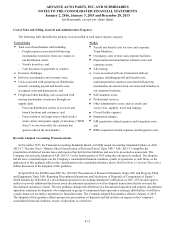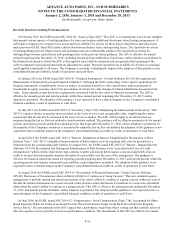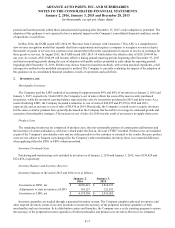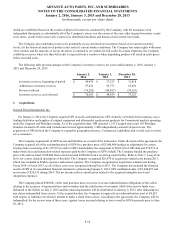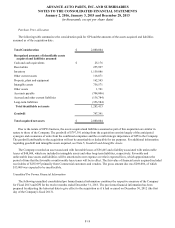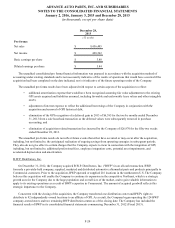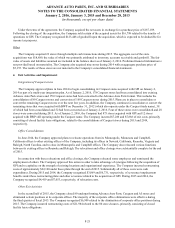Advance Auto Parts 2015 Annual Report Download - page 67
Download and view the complete annual report
Please find page 67 of the 2015 Advance Auto Parts annual report below. You can navigate through the pages in the report by either clicking on the pages listed below, or by using the keyword search tool below to find specific information within the annual report.ADVANCE AUTO PARTS, INC. AND SUBSIDIARIES
NOTES TO THE CONSOLIDATED FINANCIAL STATEMENTS
January 2, 2016, January 3, 2015 and December 28, 2013
(in thousands, except per share data)
F-13
Goodwill and Other Intangible Assets
The Company records goodwill equal to the excess of the purchase price over the fair value of identifiable net assets
acquired in business combinations. The Company tests goodwill and indefinite-lived intangible assets for impairment annually
as of the first day of the fiscal fourth quarter, or when indications of potential impairment exist. These indicators would include
a significant change in operating performance, the business climate, legal factors, competition, or a planned sale or disposition
of a significant portion of the business, among other factors. The Company reviews finite-lived intangible assets for impairment
in accordance with its policy for the valuation of long-lived assets.
Valuation of Long-Lived Assets
The Company evaluates the recoverability of its long-lived assets whenever events or changes in circumstances indicate
that the carrying amount of an asset might not be recoverable and exceeds its fair value. When such an event occurs, the
Company estimates the undiscounted future cash flows expected to result from the use of the long-lived asset (asset group) and
its eventual disposition. These impairment evaluations involve estimates of asset useful lives and future cash flows. If the
undiscounted expected future cash flows are less than the carrying amount of the asset and the carrying amount of the asset
exceeds its fair value, an impairment loss is recognized. When an impairment loss is recognized, the carrying amount of the
asset is reduced to its estimated fair value based on quoted market prices or other valuation techniques (e.g., discounted cash
flow analysis). In 2015 and 2014, the Company recognized impairment losses of $11,017 and $11,819, respectively, on various
store and corporate assets. The remaining fair value of these assets was not significant. There were no significant impairment
losses in 2013.
Earnings per Share
The Company uses the two-class method to calculate earnings per share. Under the two-class method, unvested share-
based payment awards that contain non-forfeitable rights to dividends or dividend equivalents (whether paid or unpaid) are
considered participating securities and are included in the computation of earnings per share. Certain of the Company’s shares
granted to Team Members in the form of restricted stock and restricted stock units are considered participating securities.
Accordingly, earnings per share is computed by dividing net income attributable to the Company’s common shareholders
by the weighted-average common shares outstanding during the period. The two-class method is an earnings allocation formula
that determines income per share for each class of common stock and participating security according to dividends declared
and participation rights in undistributed earnings. Diluted income per common share reflects the more dilutive earnings per
share amount calculated using the treasury stock method or the two-class method.
Basic earnings per share of common stock has been computed based on the weighted-average number of common shares
outstanding during the period, which is reduced by stock held in treasury and shares of nonvested restricted stock units. Diluted
earnings per share is calculated by including the effect of dilutive securities. Diluted earnings per share of common stock
reflects the weighted-average number of shares of common stock outstanding, outstanding deferred stock units and the impact
of outstanding stock options and stock appreciation rights (collectively “share-based awards”). Share-based awards containing
performance conditions are included in the dilution impact as those conditions are met.
Lease Accounting
The Company leases certain store locations, distribution centers, office spaces, equipment and vehicles. The total amount
of minimum rent is expensed on a straight-line basis over the initial term of the lease unless external economic factors exist
such that renewals are reasonably assured. In those instances, the renewal period would be included in the lease term for
purposes of establishing an amortization period and determining if such lease qualified as a capital or operating lease.
Differences between the calculated rent expense and cash payments are recorded as a liability within the Accrued expenses and
Other long-term liabilities captions in the accompanying consolidated balance sheets, based on the terms of the lease. Deferred
rent was $70,802 and $60,275 as of January 2, 2016 and January 3, 2015, respectively. In addition to minimum fixed rental
payments, some leases provide for contingent facility rentals. Contingent facility rentals are determined on the basis of a


